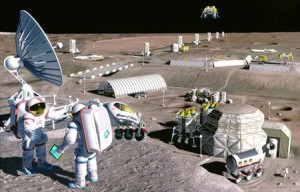Return to the Moon: Outpost or sorties?

Recently, the acting Administrator of NASA testified before Congress on his agency’s implementation of our National Space Policy, previously known as the Vision for Space Exploration (VSE). In the question and answer period, he made a rather startling statement to the effect NASA was still trying to understand what “lunar return” means - that an outpost would be “expensive” and that lunar return might instead entail a series of smaller scale sortie missions, similar to the later Apollo expeditions of the early 1970’s. He added that people should remember that the “original purpose” of the VSE was to prepare to go to Mars and other destinations.
I found this exchange fascinating because it suggests that NASA, as an executing entity, still doesn’t fully understand the nature of their mission to the Moon and to the extent that it is understood, they have transformed it into something very different from what the VSE actually said and what was intended.
To begin with, what did the Vision actually say about lunar return? The Vision consisted of both documents and speeches (all linked on this page) that included the following points:
1. The purpose of the VSE is to serve national scientific, security and economic interests. 2. The Moon is a source of material and energy resources that we can access and use to create new spacefaring capability. 3. We return to the Moon to explore it scientifically, to learn how to live and work on another world and how to extract and use lunar resources. 4. This experience on the Moon will allow us to journey beyond the Earth-Moon system, first to Mars and then to other destinations. 5. We undertake this journey with small, incremental, cumulative steps, all designed to fit under NASA's current budgetary envelope.
Apparently, the view of NASA’s acting Administrator is that the Moon is a box to be checked-off on the way to Mars. Hence, we don’t really need to establish an outpost because we’re just satisfying a political requirement in implementing policy, not conducting a technical experiment to use the Moon to prepare for journeys beyond.
Why is an outpost on the Moon necessary? Or more pressingly, why are sortie missions undesirable? Each time you go to the Moon, launch and spacecraft assets (in the form of equipment and vehicles) are expended. This equipment has significant cost; it is currently estimated that a single Orion sortie mission to the Moon might cost upwards of $ 4-5 billion dollars. A sortie mission goes to a single, specially designated landing site, the crew explores the local area, sets up some experiments and then departs. All equipment brought to the Moon is abandoned. Thus, a sortie mission’s high costs are pure expenditure, not investment. The return from sortie missions is scientific knowledge, something which as a lunar scientist, I certainly desire. But a sortie mission does little to advance the goals of learning how to live on another world or for extracting and using local resources, except for relatively short duration stays and technology demonstrations.
In contrast, an outpost at a single, optimally placed location can be built up from delivered hardware as each flight incrementally adds some equipment or facility. Thus, the cumulative capability of the outpost increases with time. This seems fairly obvious and in fact, has been recognized for many years; Arthur C. Clarke’s classic book The Exploration of Space (1951) notes:
For a considerable time all flights to the Moon would be directed to the same spot, so that material and stores could be accumulated where they would be most effective. There would be no scattering of resources over the Moon’s twelve million square miles of surface – an area almost exactly the same as that of Africa.An outpost allows infrastructure to be built up rapidly and over the long run, permits and enables more exploration than a series of sortie missions. In other words, you build up capability on the Moon first, then stage the sortie missions from the Moon rather than from the Earth. Ultimately, this permits longer and more capable exploration than would otherwise be possible. The idea that an outpost is “more expensive” than sortie missions is ludicrous; an outpost can be built at any rate that budgetary limits permit. And it represents more value for expenditure because equipment gets re-used or at a minimum, used once to the maximum extent possible.
Much of this is so obvious as to be beyond debate. Could the agency’s focus on sortie missions be because those implementing the program don’t believe in the primary mission, which is to use the Moon to learn how to live off planet? Do they think it unlikely that this will be possible or do they believe that activities on the Moon will “bog them down?” Is the strategy to advocate short duration sortie missions to “get data” and conduct their experiments before ending the program? The Vision’s purpose is clear, so one must conclude that they are eager to “check off the box” for the Moon and get to their mission of going to Mars. To do that, the first three parts of the VSE must be curtailed. As others have pointed out, the Constellation program is not optimized for the establishment of an outpost on the Moon.
A return to the Moon using the Apollo exploratory template is truly a “been there, done that” exercise in space futility. The Vision was never intended to be a repeat of Apollo – the idea was to use the Moon to create new spacefaring capabilities. This is a task that’s never even been attempted in space, let alone accomplished. It is the antithesis of “been there, done that.”
It appears that some at NASA have been successful in obfuscating the purpose of the Vision.
/https://tf-cmsv2-smithsonianmag-media.s3.amazonaws.com/accounts/headshot/blog_headshot_spudis-300x300.jpg)
/https://tf-cmsv2-smithsonianmag-media.s3.amazonaws.com/accounts/headshot/blog_headshot_spudis-300x300.jpg)